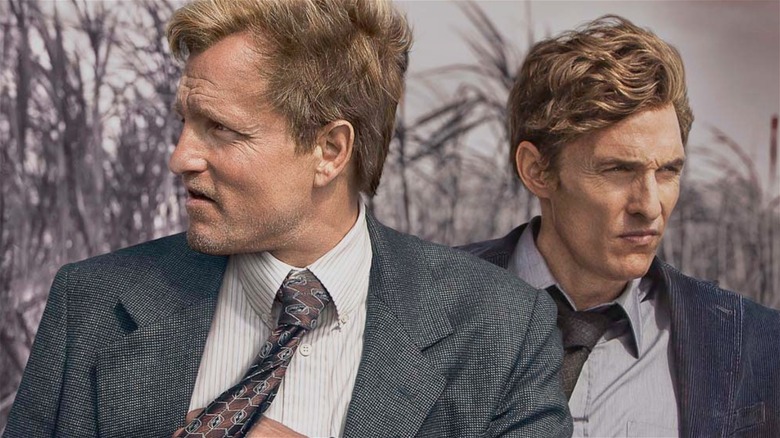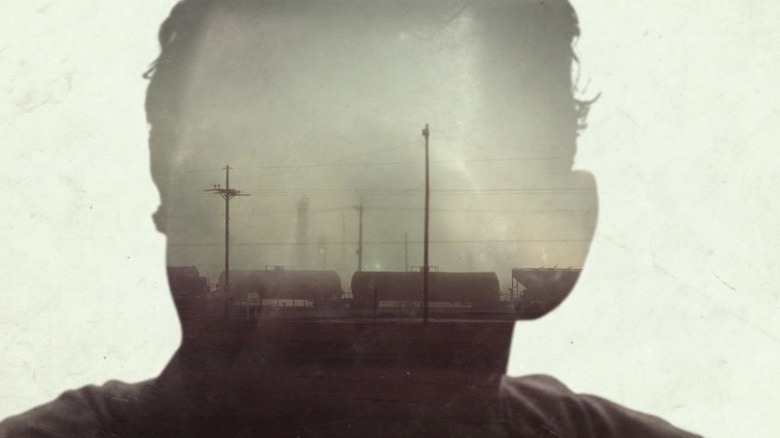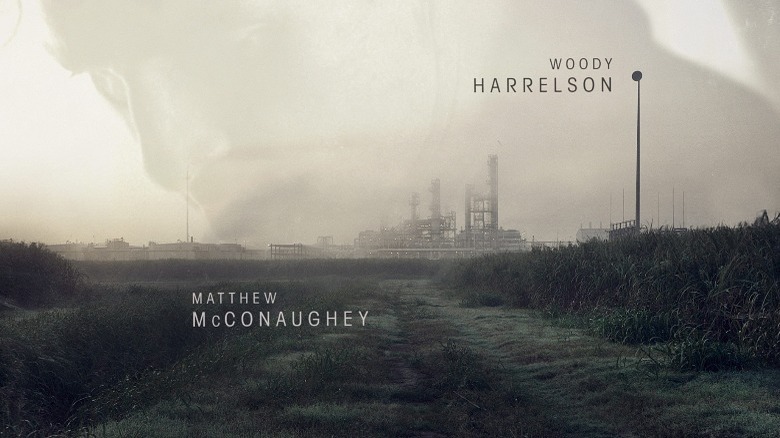A Lot Of Thought Went Into True Detective's Opening Credits
"From the dusty mesa,
Her looming shadow grows.
Hidden in the branches of the poison creosote..."
Fans of Nic Pizzolatto's "True Detective" would recognize these lyrics anywhere. "Far From Any Road" by The Handsome Family was used in the opening credits of "True Detective" season 1 to haunting effect, supplemented by striking visuals that highlighted the show's core themes in compelling ways. Although "True Detective" has had a 3-season run so far, season 1 is still considered unparalleled for its startling complexity and grim, somber tone. There's an apocalyptic feel to the first season, reflected in the lives of the characters that inhabit the broken landscape of Louisiana — an emotion that is perfectly captured by the season's unforgettable opening credits.
How did the creators manage to capture the extremely specific aura of the opening credits? The title sequence was constructed by creative director Patrick Clair, with the aid of his studios, Elastic and Antibody. From the get-go, Clair and his team shared a solid understanding of Pizzolatto's world, with its emphasis on Louisiana's industrial landscape and the broken characters who traverse it. "True Detective" opens with a harrowing murder and missing person case that is being investigated by two homicide detectives (Matthew McConaughey and Woody Harrelson). Unsavory revelations ensue about the town and its people, and Clair and his team did their best to relay this atmosphere in the opening credits. Needlessly to say, they succeeded.
Let us dive into how the credits were created, the themes they intend to evoke, and why they are so highly regarded to the point that the sequence won an Emmy for Outstanding Main Title Design in 2014.
Understanding how our environments shape us
Season 1 of "True Detective" is both grounded and otherworldly. On the one hand, it exposes the seedy underbelly of a small Louisiana town, where people's moral compasses are as poisoned as the surrounding wasteland. On the other, the evil that surrounds connects back to eldritch horrors in a metaphorical sense, hailing Robert Chambers' "The Yellow King" and the Lovecraftian concept of Carcosa. Nailing this aesthetic was a challenge for Clair and co. for many reasons. The creative director explained his process in detail during an interview with Art of the Title.
Per Clair, conversations with Pizzolatto and director Cary Fukunaga naturally gravitated towards the show's setting, and how it "revealed the characters and reflected their internal struggles." Taking this as the foundation for the credits, Clair read the script, which focused heavily on Louisiana's petrochemical industry and the environmental/infrastructural ruin it brought about. As ideas started taking shape, Clair pitched that the opening would capture "the dark and intense vision of two men at the edge of apocalypse," which is exactly how Rust and Marty's arcs play out in the series. There's complexity and contradictions within the characters, as they are torn between giving into vice while trying to be better human beings. Clair captured this divided impulse with the aid of visual metaphors and thematic symbolism.
For starters, Clair used photographic double exposures, in which human silhouettes serve as windows to physical landscapes, creating "fragmented portraits." For instance, this segment that paints a spliced photo of Rust reveals the environment he grew up in, and the torment he undergoes daily:
The same technique was used for Harrelson's Marty, while reference images were used to convey the underlying themes of the show.
The title sequence was truly a labor of love
Clair planned for the credits to be slowly engulfed by flames, featuring symbolism related to religious iconography, opposing forces, and the struggle to feel whole. As fire is a key symbol in the show, and the plot turns progressively bleaker, the credits mimic this shift from light to dark, with everything being burnt down in the end. While Clair had a clear picture of the framework, it was difficult to sync the still reference shots with footage of the actors. Clair wanted these shots to feel like "moving photographs," but the footage ended up too "kinetic" while the stills were one-dimensional. This is how Clair solved this major challenge:
"Many shots feature footage that has been digitally slowed to extreme degrees. The digital interpolation and artefacts created by slowing footage down often looks strange or tacky, but we found that in this case it evoked a surreal and floaty mood that perfectly captured what we were after ... These gave us striking and smooth character portraits to use as slow-mo windows onto our landscapes."
The surreal slow-mo footage does add a dreamy tint to the haunting photographs in the opening. Richard Misrach served as inspiration for the photos, as his art creates a dialogue between landscapes and the humans who inhabit them. Evocative shots of pollution, degradation, crime, and wildlife were used to drive the themes of the show home. Have a look:
In the shot above, doubles were used, as imagery from the show was limited. A picture of Harrelson was 3D projected, then superimposed with landscape pictures with layered textures. While the final cut was being made, distortion effects and optical glitches were added to make it look more seamless.
Why True Detective's opening credits remain unforgettable
Even if someone who has never seen the show was to watch season 1's opening credits, they would get a solid picture of the overarching themes. There is a sense of haunting beauty in the exposed photographs, as they start as wide-shot landscape portraits that transition into the sordid, microcosmic underbellies of the show's locations.
Every physical location, including the truck stops, strip clubs, forests, and churches, are sites of degradation of some kind, which Clair describes as "places ravaged by exploitation and pollution." This mirrors the reveal about the Tuttle cult in the series, made up of powerful men shaped by their inner/outer psychospheres, committing horrific crimes and leaving destruction in their wake. As the credits reach the point in which they reveal the killers' mindscapes (symbols of death, religious iconography, depictions of animalistic urges), the hues become darker, the fire becomes more intense, and the conflict within the primary characters deepens.
The level of attention to detail and care that went into the opening of "True Detective" is truly worth applauding, as few title sequences are able to inspire the emotions that it does. Clair mentioned in his pitch that the credits were meant to reveal fresh layers of meaning to viewers as they progressed through the episodes, strengthened by a deeper insight into the characters. As the title card is revealed, the cane field burns red hot, while crucifixes and gun crosshairs merge into one. After the fire consumes everything, the final shot lingers on Rust and Marty, relaying that the weight of the town's psychosphere rests on these two men, who need to fight their inner demons to defeat a greater, cosmic evil once and for all. And that is exactly what they do.




